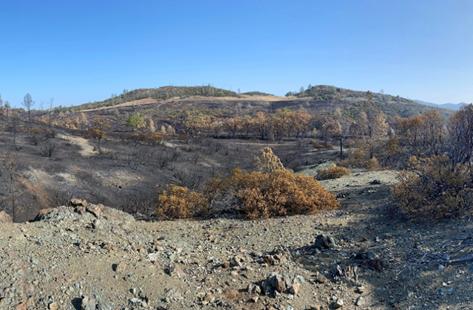New research from Stanford University shows wildfires can transform a natural element in soils into a cancer-causing and readily airborne metal known as chromium 6. Wildfires can transform a benign metal in soils and plants into toxic particles that easily become airborne, according to a new study from Stanford University.

Published Dec. 12 in Nature Communications, the research documents high levels of a hazardous form of the metal chromium at wildfire sites with chromium-rich soils and certain kinds of vegetation compared to adjacent unburned sites. Known as hexavalent chromium or chromium 6, this is the same toxin made notorious by the 2000 film Erin Brockovich.
“Our study suggests far more attention should be paid to wildfire-modified chromium, and we presume additional metals as well, to more thoroughly characterize the overall threats wildfires pose to human health,” said lead study author Alandra Lopez, a postdoctoral scholar in Earth system science at the Stanford Doerr School of Sustainability.
An overlooked hazard
Smoke plumes from wildfires are known to carry dangerous air pollutants including gases, organic aerosols, and fine particulate matter, which can trigger asthma attacks, heart attacks, and early death.
Scientists and regulators have focused less attention on potential harm from metals like chromium, which is common in soils across the western United States, Australia, Brazil, Europe, Indonesia, and South Africa. With wildfires expected to become more frequent and severe due to climate change, the health risks posed by airborne chromium to firefighters, downwind residents, and others will need to be better understood, the researchers said.
Scientific opportunity knocks
In nature, chromium mostly occurs in a form known as trivalent chromium or chromium 3, an essential nutrient that our bodies use to break down glucose. Chromium 6, which increases cancer risk when inhaled or ingested via contaminated drinking water, most often results from industrial processes. High levels of chromium 6 historically have entered the environment from industrial runoff and wastewater.
Mitigating the risks
In terms of exposure risks, fire-induced toxic chromium would initially be encountered by first responders and people living near the conflagrations. Even after fires end, local communities downwind could be exposed because strong winds may carry fine particles of chromium-laced soil.
Much of the risk of inhaling airborne hexavalent chromium would likely decline after the first big rainfall washes the metal away and underground, said Fendorf, who is also a senior fellow at the Stanford Woods Institute for the Environment. Yet before the rains come – which might take many months, especially as climate change brings more frequent and severe droughts to the American West – exposure risks would loom for people working to revegetate or rebuild burned areas, as well as recreationists checking out burn scars. More research is needed to understand potential threats to ecosystems and human health if fire-induced chromium 6 is washing into waterways or groundwater.
Source:
Stanford New Service
Provided by the IKCEST Disaster Risk Reduction Knowledge Service System
Comment list ( 0 )
